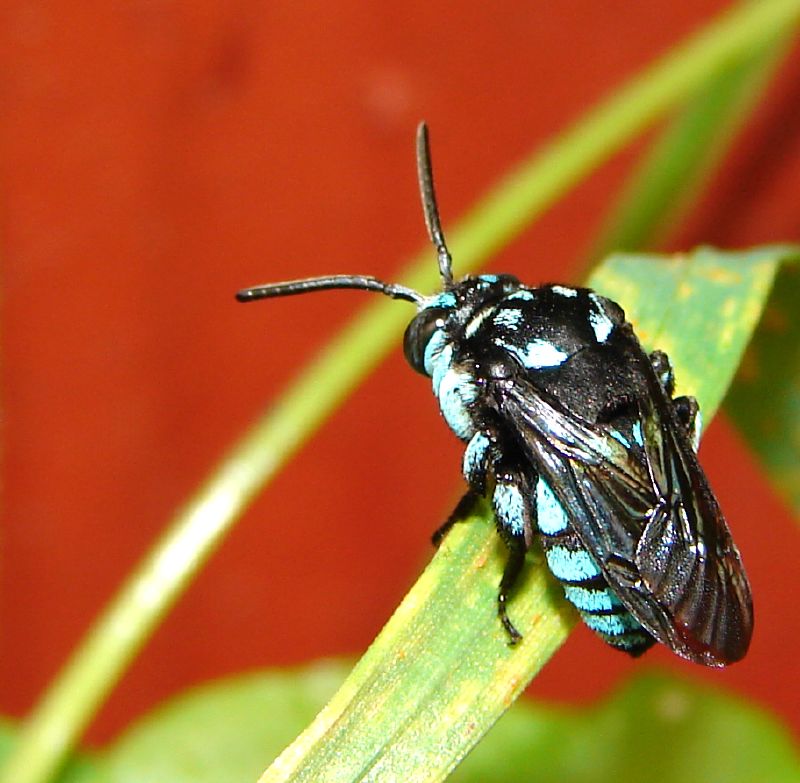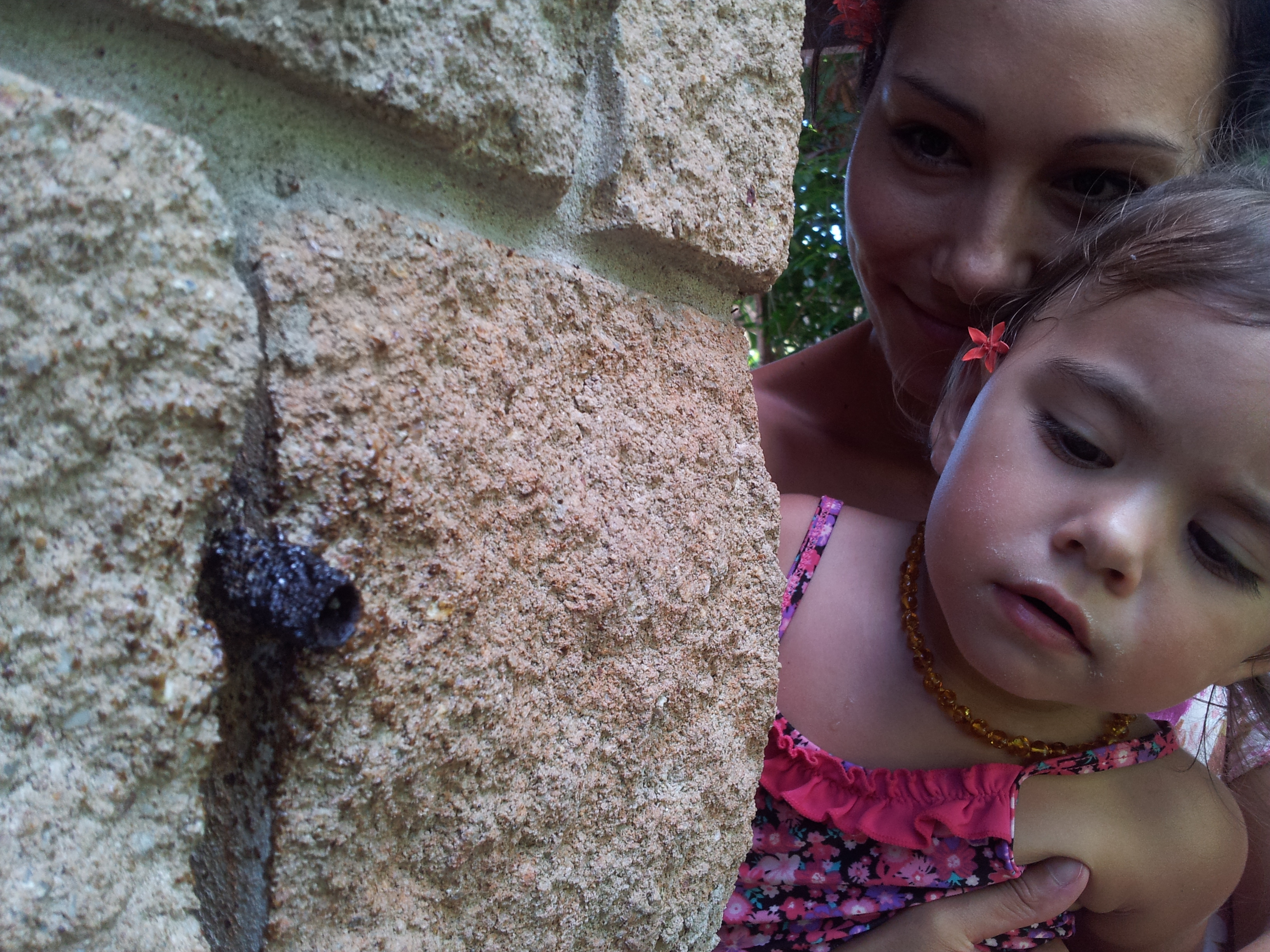Australian Native Bees on:
[Wikipedia]
[Google]
[Amazon]




 Australia has over 1,700 species of native bee. Bees collect pollen from
Australia has over 1,700 species of native bee. Bees collect pollen from
Australian bees list
Bees Hymenoptera of Australia




 Australia has over 1,700 species of native bee. Bees collect pollen from
Australia has over 1,700 species of native bee. Bees collect pollen from flower
A flower, sometimes known as a bloom or blossom, is the reproductive structure found in flowering plants (plants of the division Angiospermae). The biological function of a flower is to facilitate reproduction, usually by providing a mechani ...
s to feed their young. Flies
Flies are insects of the order Diptera, the name being derived from the Greek δι- ''di-'' "two", and πτερόν ''pteron'' "wing". Insects of this order use only a single pair of wings to fly, the hindwings having evolved into advanced m ...
do not do this, although they may be seen ''eating'' pollen, so identification is not always easy.
Sting or no sting, solitary vs social
Eleven of the species, the social native bees, are in two genera, '' Tetragonula'' and ''Austroplebeia
''Austroplebeia'' is a stingless bee (Meliponini) genus in the family Apidae. The genus was erected by Jesus Santiago Moure in 1961.
'', and have no sting.
Of the remainder, which live solitary lives, none are aggressive, and most cannot actually use their sting on human
Humans (''Homo sapiens'') are the most abundant and widespread species of primate, characterized by bipedalism and exceptional cognitive skills due to a large and complex brain. This has enabled the development of advanced tools, cultu ...
s because they are too small to do so. Larger examples of Australian native bee are capable of stinging if handled or squashed.
The stings of most Australian native species of bee will cause relatively minor discomfort to most people -- "not as painful as those of a bull ant
''Myrmecia'' is a genus of ants first established by Danish zoologist Johan Christian Fabricius in 1804. The genus is a member of the subfamily Myrmeciinae of the family Formicidae. ''Myrmecia'' is a large genus of ants, comprising at least ...
or paper wasp
Paper wasps are vespid wasps that gather fibers from dead wood and plant stems, which they mix with saliva, and use to construct nests made of gray or brown papery material. Some types of paper wasps are also sometimes called umbrella wasps, d ...
and last only a few minutes". However, they may sting more than once, and can cause an allergic reaction
Allergies, also known as allergic diseases, refer a number of conditions caused by the hypersensitivity of the immune system to typically harmless substances in the environment. These diseases include hay fever, food allergies, atopic derma ...
—increasing effect associated with repeated exposure to the antigen
In immunology, an antigen (Ag) is a molecule or molecular structure or any foreign particulate matter or a pollen grain that can bind to a specific antibody or T-cell receptor. The presence of antigens in the body may trigger an immune respons ...
.
Honey
None of the native species of bee in Australia are truehoney bee
A honey bee (also spelled honeybee) is a eusocial flying insect within the genus ''Apis'' of the bee clade, all native to Afro-Eurasia. After bees spread naturally throughout Africa and Eurasia, humans became responsible for the current cosm ...
s, which are native to Europe
Europe is a large peninsula conventionally considered a continent in its own right because of its great physical size and the weight of its history and traditions. Europe is also considered a subcontinent of Eurasia and it is located entirel ...
, Asia
Asia (, ) is one of the world's most notable geographical regions, which is either considered a continent in its own right or a subcontinent of Eurasia, which shares the continental landmass of Afro-Eurasia with Africa. Asia covers an are ...
and Africa
Africa is the world's second-largest and second-most populous continent, after Asia in both cases. At about 30.3 million km2 (11.7 million square miles) including adjacent islands, it covers 6% of Earth's total surface area ...
. Social species of native bees do produce honey, but not much, as they are relatively primitive bee species. In cool-climate areas of Australia, all the honey the bees produce is needed by the swarm to live through winter.
Collecting honey from Australian native bee nests can cause many of the bees to drown in spilt honey. The honey is tangy in comparison with commercial honey taken from the European honey bee
The western honey bee or European honey bee (''Apis mellifera'') is the most common of the 7–12 species of honey bees worldwide. The genus name ''Apis'' is Latin for "bee", and ''mellifera'' is the Latin for "honey-bearing" or "honey carrying", ...
. The bees store their honey in "small resinous pots which look like bunches of grapes".
Pollination
The different species of Australian native bee have different habits and preferences in gathering pollen, so different species are better pollinators of a given plant than other species. Research is currently underway into use of ''Amegilla'' ("blue-banded bees") for use in pollinatinghydroponic
Hydroponics is a type of horticulture and a subset of hydroculture which involves growing plants, usually crops or medicinal plants, without soil, by using water-based mineral nutrient solutions in aqueous solvents. Terrestrial or aquatic plant ...
tomato
The tomato is the edible berry of the plant ''Solanum lycopersicum'', commonly known as the tomato plant. The species originated in western South America, Mexico, and Central America. The Mexican Nahuatl word gave rise to the Spanish word ...
es, while some hydroponic growers are petition
A petition is a request to do something, most commonly addressed to a government official or public entity. Petitions to a deity are a form of prayer called supplication.
In the colloquial sense, a petition is a document addressed to some offi ...
ing for introduction to the Australian mainland
Mainland Australia is the main landmass of the Australian continent, excluding the Aru Islands, New Guinea, Tasmania, and other Australian offshore islands. The landmass also constitutes the mainland of the territory governed by the Commonwea ...
of the European bumblebee, ''Bombus terrestris
''Bombus terrestris'', the buff-tailed bumblebee or large earth bumblebee, is one of the most numerous bumblebee species in Europe. It is one of the main species used in greenhouse pollination, and so can be found in many countries and areas wher ...
''—the island continent Australia has a history of sensationally poor outcomes from introduced species
An introduced species, alien species, exotic species, adventive species, immigrant species, foreign species, non-indigenous species, or non-native species is a species living outside its native distributional range, but which has arrived ther ...
, the most famous example being that of the cane toad ''Bufo marinus
The cane toad (''Rhinella marina''), also known as the giant neotropical toad or marine toad, is a large, terrestrial true toad native to South and mainland Central America, but which has been introduced to various islands throughout Oceania ...
''—so the question of use of native vs introduced bees for pollination in Australia is controversial.
Western Australian native bees
Approximately 800 species of native bee occur inWestern Australia
Western Australia (commonly abbreviated as WA) is a state of Australia occupying the western percent of the land area of Australia excluding external territories. It is bounded by the Indian Ocean to the north and west, the Southern Ocean to th ...
, and many of them are endemic
Endemism is the state of a species being found in a single defined geographic location, such as an island, state, nation, country or other defined zone; organisms that are indigenous to a place are not endemic to it if they are also found else ...
. Like all bees, native Australian bees are a type of specialised wasp that has evolved to vegetarianism. They feed on nectar, but it is the female native Australian bee that will thicken the nectar to make honey before taking it back to the nest. Australian bees are mostly solitary insects. A female bee will build a nest with the aid of "workers". Native Australian bees face many threats, particularly from parasitic insects such as some wasps, flies and beetles.
Species
* '' Amegilla asserta'' ( Cockerell, 1926) * '' Amegilla bombiformis'' (Teddy bear bee, Golden haired mortar bee) (Smith
Smith may refer to:
People
* Metalsmith, or simply smith, a craftsman fashioning tools or works of art out of various metals
* Smith (given name)
* Smith (surname), a family name originating in England, Scotland and Ireland
** List of people wi ...
, 1854)
* '' Amegilla cingulata'' (Blue-banded bee) ( Fabricius, 1775)
* ''Amegilla dawsoni
''Amegilla dawsoni'', sometimes called the Dawson's burrowing bee, is a species of bee that nests by the thousands in arid claypans in Western Australia. It is a long tongued bee, of the tribe Anthophorini and genus ''Amegilla,'' the second l ...
'' (Dawson's burrowing bee) (Rayment, 1951)
Carpenter bees
* ''Xylocopa aerata
''Xylocopa aerata'', the golden-green carpenter bee or green carpenter bee, is one of two species of carpenter bee found only in the conservation areas around Sydney, and in the Great Dividing Range in New South Wales in Australia. Its only ...
'' (Golden-green carpenter bee, Green carpenter bee) (Smith, 1851)
* '' Xylocopa bombylans'' (Peacock carpenter bee) (Fabricius, 1775)
Reed bees
Genus '' Exoneura:'' * '' Exoneura abstrusa'' (Cockerell, 1922) * '' Exoneura albolineata'' (Cockerell, 1929) * '' Exoneura albopilosa'' (Rayment, 1951) * ''Exoneura robusta
''Exoneura robusta'' is a species of the primitively eusocial allodapine bee, belonging to the genus commonly referred to as "reed bees". Their common name derives from their use of the soft pith of dead fern fronds as a nesting material. They a ...
''
Stingless bees
* ''Austroplebeia australis
''Austroplebeia australis'' (previously and originally known as ''Trigona australis'') is a stingless bee species in the tribe Meliponini first validly described by Heinrich Friese in 1898.
Within Australia, they are occasionally referred to as b ...
'' (Friese
Friese may refer to:
* Carl Friese, an American mycologist
* Christian-Peter Friese, (1948-1970), victim at the Berlin wall
* Donald Friese (born 1940), American billionaire businessman
* Friedemann Friese (born 1970), German board game design ...
, 1898)
* ''Austroplebeia cassiae
''Austroplebeia cassiae'' is a small eusocial stingless bee first described by Cockerell in 1910 and it is found in Australia (North and Eastern Queensland).
Etymology
The name 'cassiae' was given because the first specimens were collected fr ...
'' (Cockerell, 1910)
* ''Austroplebeia cincta
''Austroplebeia cincta'' is a small eusocial stingless bee first described by Mocsáry in 1898 and it is found across Australia (far North Queensland) and Papua New Guinea (East and Centre).
Description and identification
The workers (3-4.3 m ...
'' ( Mocsáry, 1898)
* ''Austroplebeia essingtoni
''Austroplebeia essingtoni'' is a small eusocial stingless bee first described by Cockerell in 1905 and it is found in Australia (Northern areas of Western Australia and Northern Territory). They are one of the smallest stingless bees in Austra ...
'' (Cockerell, 1905)
* ''Austroplebeia magna
''Austroplebeia magna'' is a small eusocial stingless bee
Stingless bees, sometimes called stingless honey bees or simply meliponines, are a large group of bees (about 550 described species), comprising the tribe Meliponini (or subtribe Melipo ...
'' (Dollin, Dollin, & Rasmussen, 2015)
* '' Tetragonula carbonaria'' (Sugarbag bee) (Smith, 1854)
* '' Tetragonula hockingsi'' (Cockerell, 1929)
* '' Tetragonula mellipes'' (Friese, 1898)
See also
* Elizabeth Exley, an Australian native bee entomologistReferences
{{ReflistExternal links
Australian bees list
Bees Hymenoptera of Australia